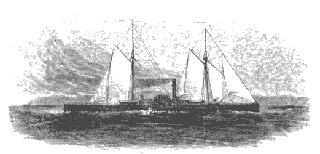WHERE THE WATEREE WAS (extract)
Southward still, leaving Montevideo with its finished civilization in manners, customs, streets, shops, and police regulations, we steamed down the eastern coast of Patagonia. On the 23d of May we entered the Strait of Magalhaen [Magellan, Ed.].
Opening winter, in a region as near utter desolation as any thing on earth, met us fairly in the face. We left the familiar Atlantic in the gloom of a sky heavy and black with storm-clouds. By the aid of a few sketches I propose to tell the story of our singular cruise through the Strait, and the almost unknown regions of inland water beyond.
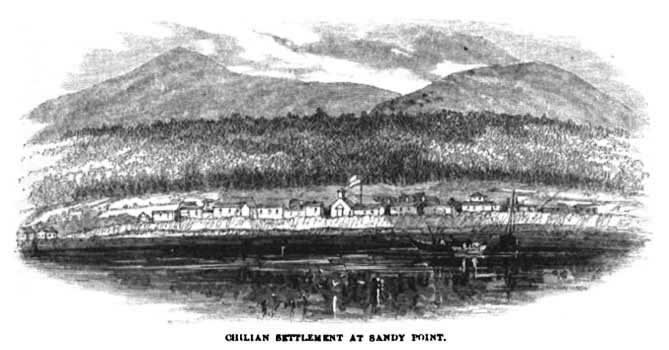 Do many people know that the Strait of Magalhaen has a governor? At
Sandy Point [Punta Arenas, Ed.]
— a hundred miles from the Atlantic — there is a village of some fifty
houses, where he lives and holds almost absolute rule over his little garrison
of one company of Chilinean infantry, and a vague number of Patagonian irregulars.
Sent there by the Government of Chili, which country claims the barren heritage
of Patagonia and Tierra del Fuego, he is now serving his third term of three
years. I introduce him with great pleasure. Governor
Schutz [Schyte, Ed.],
a Danish gentleman,
of rare scientific ability, more widely known in Europe than America; who knows
Patagonia, the Strait, the neighboring islands, and the inhabitants of these
regions better than anyone else; and who will, I trust, some day give the world
the results of his tedious residence and studies at Sandy Point.
Do many people know that the Strait of Magalhaen has a governor? At
Sandy Point [Punta Arenas, Ed.]
— a hundred miles from the Atlantic — there is a village of some fifty
houses, where he lives and holds almost absolute rule over his little garrison
of one company of Chilinean infantry, and a vague number of Patagonian irregulars.
Sent there by the Government of Chili, which country claims the barren heritage
of Patagonia and Tierra del Fuego, he is now serving his third term of three
years. I introduce him with great pleasure. Governor
Schutz [Schyte, Ed.],
a Danish gentleman,
of rare scientific ability, more widely known in Europe than America; who knows
Patagonia, the Strait, the neighboring islands, and the inhabitants of these
regions better than anyone else; and who will, I trust, some day give the world
the results of his tedious residence and studies at Sandy Point.
I was pleased to find my old idea of the great size of the Patagonian Indians verified. Deriving it as a child from Malte Brun [Danish geographer, Ed.], I had kept it, despite contradiction of all sorts, till the Governor showed me the result of many measurements taken among the native men by himself resulting in an average height of between five feet eleven inches and six feet.
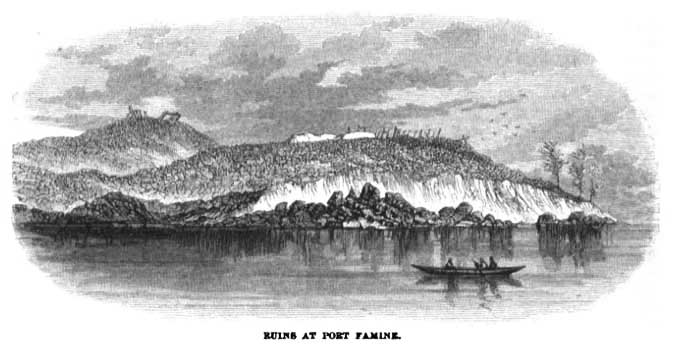 From Sandy Point to Port Famine, thirty miles further. Here we anchored in
a driving snow-storm that would have been creditable to New England in January.
In an hour afterward the storm cleared away. The harbor of Port Famine, even
in winter weather, is one of the loveliest spots that I ever saw. One singular
fact, unnoticed as far as I have seen in any description of the country, is
the absence of any deciduous tree in Patagonia, even in mid winter. Not that
the ordinary evergreens of the North form the mass of the forests. On the contrary,
a great variety of all sorts of trees, among which are duplicates of the maple
and oak of our own country, outnumber the spruces, pines, and cedars, common
in the higher latitudes all over the world. Grass grows fresh and green beneath
the snow, and I gathered butter-cups in a temperature of 32° Fahrenheit,
in the old cemetery on the bluff above the harbor mouth at this point.
From Sandy Point to Port Famine, thirty miles further. Here we anchored in
a driving snow-storm that would have been creditable to New England in January.
In an hour afterward the storm cleared away. The harbor of Port Famine, even
in winter weather, is one of the loveliest spots that I ever saw. One singular
fact, unnoticed as far as I have seen in any description of the country, is
the absence of any deciduous tree in Patagonia, even in mid winter. Not that
the ordinary evergreens of the North form the mass of the forests. On the contrary,
a great variety of all sorts of trees, among which are duplicates of the maple
and oak of our own country, outnumber the spruces, pines, and cedars, common
in the higher latitudes all over the world. Grass grows fresh and green beneath
the snow, and I gathered butter-cups in a temperature of 32° Fahrenheit,
in the old cemetery on the bluff above the harbor mouth at this point.
With sunshine and fair weather we went ashore. Port Famine has a historical fame. Centuries ago a colony from Spain perished wretchedly here from want of food. Some twenty years since a Chilinean settlement for convicts met its death by a revolt of the prisoners — who rose on their guards, murdered men, women, and children, captured a trading schooner at anchor in the harbor, massacred its crew, and sailed away. It is pleasant to know that these convict pirates were afterward punished. At Ancud, in Chiloe Island, the place is shown where they were pulled in pieces by horses; in the same style in which a certain King of France put the supposed assassin Damiens to death. Ruins of frame-houses crown the high land on the northern side of the harbor. A square inclosure, surrounded by a half-decayed fence of wooden pickets, shows the plaza of the convict-village, afterward the burial-ground of the victims of the massacre. A wooden cross stood in its centre a few years ago. Visitors to the place, though very few in number, have hacked this away till a stump, a yard in height, is all that remains of it. Graves are scattered thickly around. An old earth-work, with two or three corroding guns, overlooks the cemetery and the ruins. The story of the misfortunes of Port Famine was told to me by Governor Schutz, while I sat in his comfortable library at Sandy Point. The view from the window took in the broad expanse of the Straits, with the snow-covered mountains of Tierra del Fuego on the southern side. A scene of desolation. A region without house or hut in sight, beyond the fifty or sixty that made the Governor's village. Sitting there at case, in a room whose appointments were the same as those of any similar room at home, smoking a choice cigar and tasting very fine old sherry meanwhile, it was hard to realize that only two mails in a year were possible for the Governor, so far removed is his house from the outer world.
More than a hundred mountain peaks are within range of vision from the plateau where the ruins of Port Famine stand. A vast inland lake terminates thirty miles to the southward in the entrance to Magdalen Sound — a passage to the Southern Pacific, cut through the mountains of Tierra del Fuego. Narrow, twisted, walled in by high cliffs, a channel whose waters have never seen the sun, it is filled with shoals and sunken rocks; round and over which the breakers beat unceasingly. The naturalist Darwin says, very truly, that it resembles an avenue to another and a worse world.
From Port Famine to Port Gallant; rounding the southern most point of the main land of America, Cape Froward, a black and weatherworn rock, a thousand feet in height, in a strong gale from the south. Port Gallant was the first of the many harbors of the same kind in which we were destined to pass dreary southern winter nights before entering the open ocean again. They seem like sunken craters. A crevice in the side admits the ship into a well whose walls are mountains. Hardly one of them is large enough to hold more than one or two ships at a time. As harbors they are perfect. The fiercest storms outside leave their surface unruffled. Their silence at night is something unnatural. In some of them, cascades of pure and cold water come down from thousands of feet above, in dust-falls, shivered into spray far up in the air. In others the strange "side-wheel" duck paddles through the darkness, alarmed by some movement on the vessel. The utter stillness of these little bays was broken by such sounds only.
The "side-wheel" ducks made their first appearance as we entered the Strait. I believe they are found only in Patagonia. Discarding their wings as instruments for flying and their feet as paddles, they use their wings as wheels: never rising from the water even when pursued, but rushing ahead at great speed, leaving wakes behind them precisely like those of paddle-steamers. An examination of their wings showed a cartilaginous projection at the elbow, with which they undoubtedly strike the water; but while in motion the rapidity of their movement was such that any attempt to analyze its nature was impossible. A gray mist at either side of the body was the only visible means of progression; while their feet dragged after them on the surface. When approached too closely they dive. I never saw one leave the water, or make any attempt to fly.
Leaving Port Gallant on Sunday morning, our route for the day lay, straight as if drawn by rules, down the middle of a majestic aisle, sixty miles in length, with side-walls of mountain headlands and cliffs. They met in the clear distance in perspective. This superb channel, with a constant succession of the wildest Alpine scenery on either side, snow-capped mountains, deep ravines, high precipices, and immense glaciers, that filled long gorges, and spread out into seas of ice at intervals, is known as "Crooked Reach." The name seemed to me very illy given.
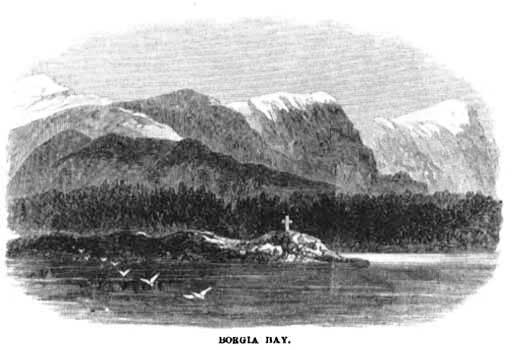 Borgia Bay, Port Tamar, and the Strait of Magalhaen itself were left behind
in two days more. The strange portion of our cruise began. From the Strait
to Tres Montes Peninsula, through six degrees of latitude, a series of intricate
inland channels lie among the Patagonian islands. Their general course is northward.
They are known in succession as Smith's, Sarmiento, and Mesier channels. These
principal passages have many connections, short cuts, and intermediate channels,
making a somewhat labyrinthine tract of water that is seldom traversed by any
other vessels than sealing schooners, and by these at long intervals. The surveys
of Admiral Fitzroy, of the English navy, are the basis for the charts of these
inland waters; and even those are so far from correct at some points, that
our steamer, traveling by daylight only, had to feel her way, sometimes for
miles, by the lead-line. We had passed a week in the Strait of Magalhaen, and
headed north again for our next port, Valparaiso.
Borgia Bay, Port Tamar, and the Strait of Magalhaen itself were left behind
in two days more. The strange portion of our cruise began. From the Strait
to Tres Montes Peninsula, through six degrees of latitude, a series of intricate
inland channels lie among the Patagonian islands. Their general course is northward.
They are known in succession as Smith's, Sarmiento, and Mesier channels. These
principal passages have many connections, short cuts, and intermediate channels,
making a somewhat labyrinthine tract of water that is seldom traversed by any
other vessels than sealing schooners, and by these at long intervals. The surveys
of Admiral Fitzroy, of the English navy, are the basis for the charts of these
inland waters; and even those are so far from correct at some points, that
our steamer, traveling by daylight only, had to feel her way, sometimes for
miles, by the lead-line. We had passed a week in the Strait of Magalhaen, and
headed north again for our next port, Valparaiso.
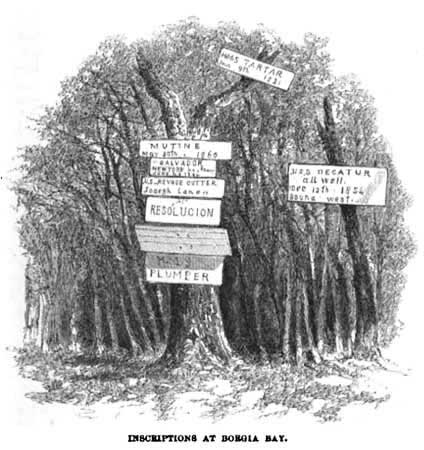 An old custom exists among
the voyagers of the Strait, of leaving the names of their ships, with some
records of their cruises, at the different anchorages. At Borgia Bay was a
large collection of records of this sort, painted boards nailed on the trees.
Among them the names of the United States ship Decatur, which staid in the
Strait weather-bound for two months, about ten years ago; and the Resolucion,
one of the Spanish vessels that seized the Chincha islands. One captain had
recorded his command as a "whaling skuner."
An old custom exists among
the voyagers of the Strait, of leaving the names of their ships, with some
records of their cruises, at the different anchorages. At Borgia Bay was a
large collection of records of this sort, painted boards nailed on the trees.
Among them the names of the United States ship Decatur, which staid in the
Strait weather-bound for two months, about ten years ago; and the Resolucion,
one of the Spanish vessels that seized the Chincha islands. One captain had
recorded his command as a "whaling skuner."
At two or three points we found excellent opportunities for hunting the guanaco, a species of llama, valued for its flesh, which resembles beef, and its fur. The Patagonians (literally, "men with large feet") make robes of the guanaco skins, sewing several together, using them for winter clothing. As the men have no beard it becomes difficult to distinguish the sexes when both are seen in company. An intense plainness and similarity of feature characterize the nation. One female of eighteen years that I saw with her mother might have been almost any age or of either sex, so far as any appearance of face, dress, or figure was concerned.
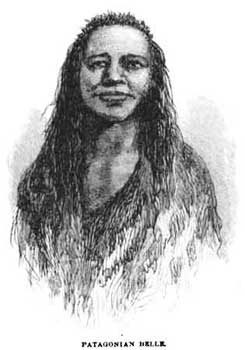 We hunted guanacos and ostriches. They both abound in the more level country
at the eastern end of the Strait. They are very shy, and we met with no success
in our hunts. At Sandy Point the natives offered finished robes for sale. I
found one an admirable bed-covering in the winter weather.
We hunted guanacos and ostriches. They both abound in the more level country
at the eastern end of the Strait. They are very shy, and we met with no success
in our hunts. At Sandy Point the natives offered finished robes for sale. I
found one an admirable bed-covering in the winter weather.
I use the term "we" in the plural number. The officers of the ship were twenty in all. Eight of us, more nearly allied by a common residence in the ward-room and its eight tributary state-rooms, were the chief explorers and sportsmen. The captain, well known in the service as an expert and daring navigator, led us all, however. Neither cold nor exposure seemed to daunt him whenever, in our numerous anchorages, any signs of game worth securing were seen. He and a young relative who shared his cabin, as ardent a sportsman as the captain, furnished us in the ward-room with many a meal of unknown fowls in the dreary days when cold and impending scarcity of food made the fowling-piece or rifle our only hope.
Twenty officers and one hundred and eighty-six men thrown upon their own resources (or amusement in a long voyage find under most favorable circumstances some trouble in realizing any. For some of us in the ward-room it was a first cruise of any length. My own previous sea-going had been wholly on the blockade. Four of the eight had but just entered the naval from the merchant service. Three of us were in the regular service, and five in the volunteer. This mingling of the two branches, far more in the navy than the army, becomes unfortunate. Officers on ship-board are necessarily thrown so much more together than those on shore, and small jealousies have so much fairer a field in which to work. Yet the evil is insurmountable in such a war as ours, and will perhaps work its own cure in time.
With us affairs went on with tolerable smoothness. A punning man, two common-sense men, a careful man, a talkative man, an eccentric man, and two negative men were sufficiently distinct in personality to give some zest to conversation. Then one of the common-sense men was an inveterate grumbler, and afforded enjoyment to the others from that peculiarity.
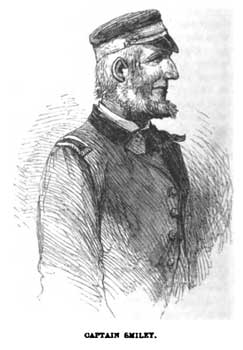 I ought not to leave the Strait without speaking of its oldest living habitué,
Captain Smiley, of the Falkland Islands
[William H. Smiley, U.S. consul, Ed.]
The captain is a remarkable example
of the fact that sailors may sometimes live to advanced age, and keep in perfect
health. He acknowledges a residence of fifty-five years in the high latitudes
of the Southern Hemisphere ; but an old gentleman of Montevideo told me he
had known Smiley personally for over seventy years, and that when he first
saw him he was a full grown man. Smiley's age must in that event, be nearly
ninety. His appearance and actions are those of a well preserved and active
man of fifty years or thereabouts. He is known by every one, civilised and
barbarian, from Uruguay down to Chili. I was assured by a captain, who was
wrecked on the eastern coast of Patagonia, that Smiley scented the disaster
six hundred miles away, and came with assistance. His services to shipwrecked
vessels have been numerous and invaluable; and he has, I am glad to know, accumulated
a large fortune as the result of a life filled with good actions enough to
counterbalance the many hard stores told of him — stories with foundation,
I fear, but left to his biographer. Parton or Brantz Mayer would find material
for a full volume in the old gentleman's career. He is the only man I have
met who has rounded Cape Horn alone. This he did in a fifty ton schooner. His
personal acquaintances with the Fuegian and Patagonian natives is large. He
mentioned to me a call that he made a few years since on an old friend, a Fuegian
chief, and found him devouring choice cuts from his wife's body, killed, as
the chief remarked, to satisfy his curiosity as to the form in which she would
prove most pleasing. Cannibalism still exists in Tierra del Fuego.
I ought not to leave the Strait without speaking of its oldest living habitué,
Captain Smiley, of the Falkland Islands
[William H. Smiley, U.S. consul, Ed.]
The captain is a remarkable example
of the fact that sailors may sometimes live to advanced age, and keep in perfect
health. He acknowledges a residence of fifty-five years in the high latitudes
of the Southern Hemisphere ; but an old gentleman of Montevideo told me he
had known Smiley personally for over seventy years, and that when he first
saw him he was a full grown man. Smiley's age must in that event, be nearly
ninety. His appearance and actions are those of a well preserved and active
man of fifty years or thereabouts. He is known by every one, civilised and
barbarian, from Uruguay down to Chili. I was assured by a captain, who was
wrecked on the eastern coast of Patagonia, that Smiley scented the disaster
six hundred miles away, and came with assistance. His services to shipwrecked
vessels have been numerous and invaluable; and he has, I am glad to know, accumulated
a large fortune as the result of a life filled with good actions enough to
counterbalance the many hard stores told of him — stories with foundation,
I fear, but left to his biographer. Parton or Brantz Mayer would find material
for a full volume in the old gentleman's career. He is the only man I have
met who has rounded Cape Horn alone. This he did in a fifty ton schooner. His
personal acquaintances with the Fuegian and Patagonian natives is large. He
mentioned to me a call that he made a few years since on an old friend, a Fuegian
chief, and found him devouring choice cuts from his wife's body, killed, as
the chief remarked, to satisfy his curiosity as to the form in which she would
prove most pleasing. Cannibalism still exists in Tierra del Fuego.
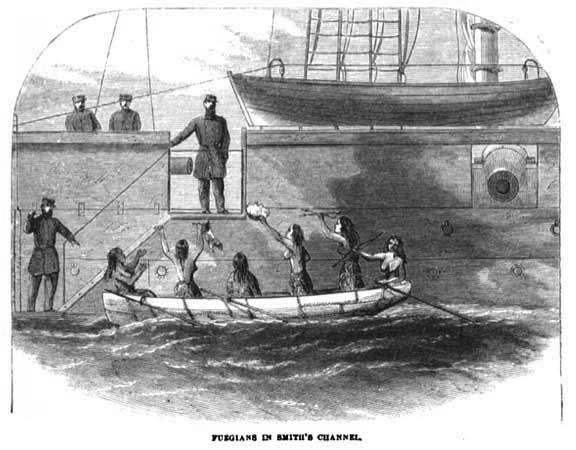 One canoe-load of these Fuegians boarded us one stormy day; a family party — father,
mother, sons, and daughters. Though the thermometer stood at 40 degrees, they
were entirely naked, save a small piece of seal-skin, two feet square, worn
round the shoulders by the matron and others of the party, about the waist
by the rest. I saw no trace of anything but the most complete barbarism in
their appearance. Physically, they were far inferior to the Patagonians. They
bartered bows and arrows for tobacco. Their fear of the steamer and her wheels,
which last they seemed to think were alive, was something painfully ludicrous.
One canoe-load of these Fuegians boarded us one stormy day; a family party — father,
mother, sons, and daughters. Though the thermometer stood at 40 degrees, they
were entirely naked, save a small piece of seal-skin, two feet square, worn
round the shoulders by the matron and others of the party, about the waist
by the rest. I saw no trace of anything but the most complete barbarism in
their appearance. Physically, they were far inferior to the Patagonians. They
bartered bows and arrows for tobacco. Their fear of the steamer and her wheels,
which last they seemed to think were alive, was something painfully ludicrous.
Northward, up Smith's Channel, snow, rain, bergs of floating ice broken from the glaciers that fill every valley in the mountains and islands of southwestern Patagonia, cold winds, and clouded skies were our greeting to the strange passages we entered. The evergreen vegetation covered all the land that the glaciers left exposed.
We held our course day after day in mid-channel; not to secure sufficient depth of water, for the lead-line rarely found bottom at less than fifty fathoms close to the shore, except in the little crater harbors of which Port Gallant was the type. The outlying islands seem to have been riven from the continent by some splitting force in past ages. The mountains on either hand carry their steep slope down below the surface till they meet hundreds of fathoms deep beneath the sea level. The abomination of desolation covers land and water. Neither human nor brute life could be seen on shore; and the few water-fowls, the cape-pigeon, with its harlequin plumage, the albatross, the mysterious fish-hawk, with face like a death's-head, flew round the ship with melancholy cries that only made the loneliness of the region more real. These sea-birds are tame compared with those on land. Sailors rarely injure them. Many believe, in fact, that the souls of dead mariners are embodied in these restless creatures, and have a kindly feeling for them in consequence. The same birds will follow a ship for weeks. I know of one instance where an albatross, caught and marked with a red ribbon about its leg, and then released, flew three thousand miles in company with a vessel before it left her, from necessity being on the wing almost unceasingly for that immense distance. The Ancient Mariner's yarn is true to fact in that description at least.
Welcome Bay was our first night's anchorage after leaving Port Tamar. Its features were not peculiar. The mountain walls that shut out the sky, with a foamy line of falling water drawn on one precipitous hill-side, showed nothing new. By daylight next morning we were again under way.
Days more of the same superb but wearying scenery, anchoring every night. As far as Saumarez Island at length, where Sarmiento and Mesier channels meet. Here, in the sudden darkness of a snow-squall, just at sunset, we for the first time lost our harbor for the night. The chart gave Sandy Bay as an available anchorage, but to find Sandy Bay in the intense darkness was impossible. The situation was awkward. By daylight every sunken rock is buoyed out by kelp floating on the water, and always meaning possible danger. The sunken rocks are very abundant. The depth on them may be from one fathom to several; and just outside their boundary lines of floating kelp the sounding lead may find no bottom. Moving slowly through the night, we knew that each turn of our paddle-wheels might crash us against some one of them, and end our cruise at once. Boats with lanterns were sent out, but their lights flashed only against the black mountains sides, and showed no opening within which our wished-for harbor might be hidden. All night long the vessel crawled aimlessly about, or lay still, disheartened by continued failures, till at length the morning came and found her safe. Safe, and nearly where the darkness met her. How many times in the night destruction had been near her is known only to Him who guarded her from it.
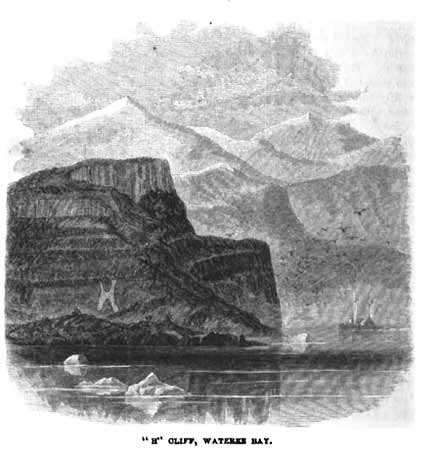 A novelty came with the morning. Mesier Channel entrance was filled from shore
to shore with bergs and floes of ice. Far beyond we could see the open water,
but to reach it in that direction was impossible. The chart showed a side channel
winding round to the eastward of an island near us, and re-entrant in Mesier
some miles further north. To try to pass through this was our only resource.
Our very light draught of water enabled us to do feats of navigation impossible
to most ships of a thousand tons, and gave feelings of security in such attempts.
A novelty came with the morning. Mesier Channel entrance was filled from shore
to shore with bergs and floes of ice. Far beyond we could see the open water,
but to reach it in that direction was impossible. The chart showed a side channel
winding round to the eastward of an island near us, and re-entrant in Mesier
some miles further north. To try to pass through this was our only resource.
Our very light draught of water enabled us to do feats of navigation impossible
to most ships of a thousand tons, and gave feelings of security in such attempts.
From some error in survey, and consequent mistake in the chart, this eastward channel proved a myth. As we moved slowly through its supposed commencement, the mountains on either hand approached, till at length they met. A narrow passage of egress on the right hand, unmarked save as an indentation of the shore upon the chart, seemed to show an outlet from their cul-de-sac. We headed for it. Winding through a tortuous lane of water, a large landlocked bay suddenly opened before us.
If surveys, charts, and records tell the truth, we were the first that ever burst into that silent sea. It spread out like an inland lake. Still and placid, walled by strange cliffs thousands of feet in height, that opened here and there in outlets of ravines that came down from valleys between the distant and overtopping mountains in the back-ground, each valley and its terminal ravine filled with a vast river of ice, overlaid in its frozen billows with drifted snow, the unknown bay was set with islands, each covered to the water's edge by the dense verdure of a Patagonian winter. The high precipices shut out every wind. Our ship moved on among the islands, each turn showing us some new beauty in the strange combination of mountain glaciers, woodland, and unruffled waters.
To its farthest limit, finding no passage out. We turned back. There was no resource left but to try the main entrance to Mesier again ; hoping that the tide had set the ice-fields in motion and cleared our way.
We named the new-found water after our ship. Some of the more marked localities were christened also. One high cliff of curiously intermingled red sandstone and white marble bore on its perpendicular face a giant "H", done in marble mosaic on the dark sandstone. A species of geological eccentricity. Looming behind a glacier at another point there rose a snow-covered mountain, with a broad summit that was shaped, in the smoothest and purest white, in a giant likeness of a woman's breast. As if some Titanic sculptor had begun to fashion the inland mountain range into the effigy of a sleeping Venus, and had ceased when this exquisite fragment of his toil was done.
Mesier Channel was clear when we came to it again. A few small bergs were coming down with the tide, but the great fields of ice had gone. We went on steadily northward. Between us and the open Pacific were only two days more of steaming ; and Valparaiso, with news from home, was but a few hundred miles beyond. It was the fifth day of June. Three months had passed since we came away, and in that time neither newspaper nor letter had reached us. The war might have ended for aught we knew. Bets were offered, and found ready takers upon all conceivable contingencies of home affairs. Our careful man had "hedged" to such an extent that when, long after we reached civilization, no one in the ward-room could unravel the intricate chain of wagers, and we were forced to declare all of them "off."
The two days passed. We left the inland channels with a slight regret. Their canal-like navigation had grown natural by weeks of continuance; and to be under way after sunset was a rather disagreeable novelty. I think on our last night but one we tied up to the bank, in Mississippi river style, finding no bottom in the channel, and no harbor for anchoring.
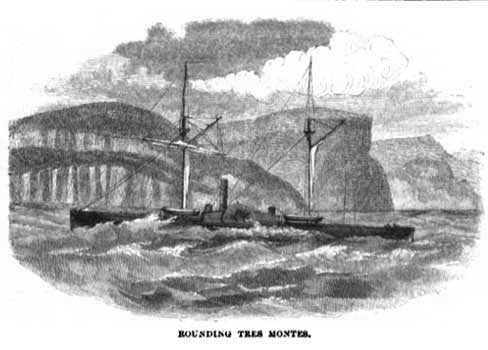 Round the peninsula of the Three Mountains, and up on the outer side of the
islands which lie north of it. And here two unpleasant facts came upon us at
once. A heavy gale with rain and snow, and an announcement that only one day's
coal remained in our bunkers. We could have weathered the storm, but coal was
our life. Our sailing abilities were on a par with those of a ferryboat destitute
of fuel. We left Montevideo with coal stowed in every available part of the
ship, but from some deception or misconception there, or some undiscovered
waste on board, it was thus nearly gone.
Round the peninsula of the Three Mountains, and up on the outer side of the
islands which lie north of it. And here two unpleasant facts came upon us at
once. A heavy gale with rain and snow, and an announcement that only one day's
coal remained in our bunkers. We could have weathered the storm, but coal was
our life. Our sailing abilities were on a par with those of a ferryboat destitute
of fuel. We left Montevideo with coal stowed in every available part of the
ship, but from some deception or misconception there, or some undiscovered
waste on board, it was thus nearly gone.
Only one course could be taken. A harbor at once had to be found, and it fortunately existed in Narborough Island, one of the group known as the Chonos Archipelago, twenty miles from us to the northeast. We fought our way toward it against the gale, and let go our anchor there on the 8th of June, a little after mid-day.
Our short cruise to Valparaiso was a thing of the future now. Wood-cutting, slow steaming, crawling by degrees from island to island till some coal station could be found, were to be the rule for weeks, months perhaps. No one could tell how long. The heavy rain and the blank desolation of our anchorage at Narborough aided the vague feeling of misfortune that came over every one on board. I should except our captain. Trained by the severe experience of four shipwrecks (among them that of the steamer San Francisco, where he was forced, although a passenger, to assume the heaviest responsibilities), he seemed little depressed by the delay, and gave courage and hope to others by his equanimity.
Nine days in Narborough with ceaseless rain. Sickness came among the crew. A case of scurvy appeared, with the slight consolation to my mind that its victim was filthy enough in personal habits to contract almost any disease idiopathically. One poor fellow, who had been under medical treatment for a long while, died of tubercular consumption, and was buried on the island. I read the burial-service over his grave with the feeling that others might follow him if our stay in Patagonia should be a lengthened one. I could give little encouragement to my patients when such small prospect of a change for the better in our movements existed.
Through these nine days our men were cutting wood for the furnaces, and bringing it off to the ship. It was water-soaked and almost uninflammable. A few tons of coal were left to use as a base for the wood fires; and on the 17th of June we got up steam, after infinite labor, and ran slowly out of the most dismal harbor I ever saw. We hoped to reach some port to the north, where we could again cut wood or find a little coal. We meant at least to get inside the islands again, and run our northward course to Chiloe Island in smooth water. Man proposes. Our nine days' cutting of wood gave us but six hours' steam, and we anchored again in the afternoon in a secluded little harbor in an unnamed island, fifteen miles east of Narborough, trying to solve the problem of our future movements. If more than a week's work at gathering wood resulted in fifteen miles' steaming, how long would it take us to reach Chiloe, two hundred miles away? The answer was unsatisfactory. And fresh discomfort came now from the exhaustion of our choicer provisions in the officers' messes, our "coming down on our rations" in consequence, and the paymaster's announcement that of these even there was but three weeks' supply in the ship. We smoked our pipes, wondered whether our stock of tobacco would give out as well, and reflected gloomily on the probable event of our becoming resident Patagonians during the ensuing season — with mussels, snails, kelp-geese, and other delicacies of the sort, for permanent diet.
I made an interesting culinary discovery during our period of semi-starvation. The kelp-goose, which, when cooked in the ordinary way, has a strong savor of old lamp-oil, may be entirely deprived of that, and every other taste, by boiling it for a day in salt-water, for another day in fresh, and roasting it on the third day. A very tender mass of fibrous and muscular tissue is the result, which satisfies hunger if it does not nourish.
We called this second harbor the Bay of the 17th of June. The chart ignored its existence even. I said the island was unnamed. As I sit writing in my state-room this evening — the ship being some eight hundred miles south of San Francisco, and running for that port against a stiff norther, with one hundred and sixty tons of coal on board, and twenty or thirty cases of remittent fever, a legacy from our last ports, Acapulco and Magdalena Bay — a brother officer reminds me that it was called Stokes's Island. For the benefit of visitors to the Chonos Archipelago I would recommend this Bay of the 17th of June. It lies in the northeastern corner of the island, and is as convenient and safe as an anchorage can be. Kelp-geese are abundant, but very hard to kill. It may be interesting to know that one of them disposed of three Sharpe's or Spencer's rifle-bullets, in some mysterious way, that were fired at him and that certainly hit him, and then flew quietly away. The water-fowls are the only game there. From end to end of the Patagonian coast we found no fish that would bite at a baited hook; and the larger land game ceases at Port Famine, in the Strait of Magalhaen, where the sea-coast forest begins. Seals are as abundant as fish are seemingly rare. Their familiar human eyes reminded me many times of the old Aquarial Gardens in Central Court, in Boston, where Mr. Cutting used to demonstrate how thoroughly they might be tamed. I saw them in Sarmiento Channel swimming in compact column, with curious and regular somersaults of the entire column by files as they swam, completely filling a mile of water in width and more than that in length.
Wood-cutting went on with more ease in Stokes's Island than it did in Narborough. Pleasant weather and more agreeable scenery aided the efforts of the men; and after two days' stay we started out again. The chart gave a winding but broad and deep channel among the northern islands of the Chonos group, that lead into the wide strait between them and the main land, that is known as the Chonos Gulf. Ninulac Channel and Memory Passage are the names given to the different portions of this winding way.
In smooth water we steamed easily along, expecting soon to reach the gulf. An awkward surprise awaited us. In place of Fitzroy's ample egress from the Ninulac Channel, a most decided barrier of firm land stretched right across our path. Evening was near, and our only choice was another anchorage, with more days of wood-cutting to replenish our nearly exhausted stock. Somebody on board shot an albatross one day while the ship was in the channel of Sarmiento. The incident came up in the memory of some of our officers, and the Ancient Mariner's disasters after a similar act were freely cited as likely to find a parallel in our own case. Affairs began to look as if this might be so. Still wood-cutting went on through the next day; and then, retracing our course, and trying every avenue that seemed to run eastward, we at length fairly squeezed through an opening that was never intended for a thousand-ton ship to use, and came out into Chonos Gulf. A clear channel of inland water stretched from where we were to Chiloe Island, fresh provisions, and possible coal But a hundred and eighty miles of distance — only a day's work with proper fuel; but with nothing save wood to burn, it became a task of very indefinite length. And just here, as we entered the gulf, our wood gave out again.
I hardly remember how many times more we ran in behind some projecting headland, anchored, and sent our hewers of wood ashore. Sunday Harbor, Delay Harbor, Hindrance Bay — names of our own giving — each mark a place where this sort of work was done. I think that at Hindrance Bay we accomplished the feat of getting wood enough on board to give a hundred miles of steaming, and a hope of going back to civilization again. At noon of the day after we left there we entered the inlet that nearly divides the Island of Chiloe in two, leading up from the Corcovado Gulf to the ancient city of Castro.
For fifteen miles the inlet runs through scenery like that of the Rhine. The high hills on either side come down in slopes and terraces to the water; and every where farm-houses and cultivated fields give a completed appearance to the country. Rarely, even in New England, I have I seen such a finished landscape. Fences and walls mark the limits of the different fields that were mapped out on the hill-side in varied shades of green. There seemed to be no waste land. A golden haze, resembling vaguely that of an Indian summer at home, covered shore and river as our ship steamed slowly through the windings of the inlet toward the city. From desolation and wilderness in the morning into a land of plenty at night !
Author: Dr. George T. Shipley
Uploaded: 07-VII-2013
